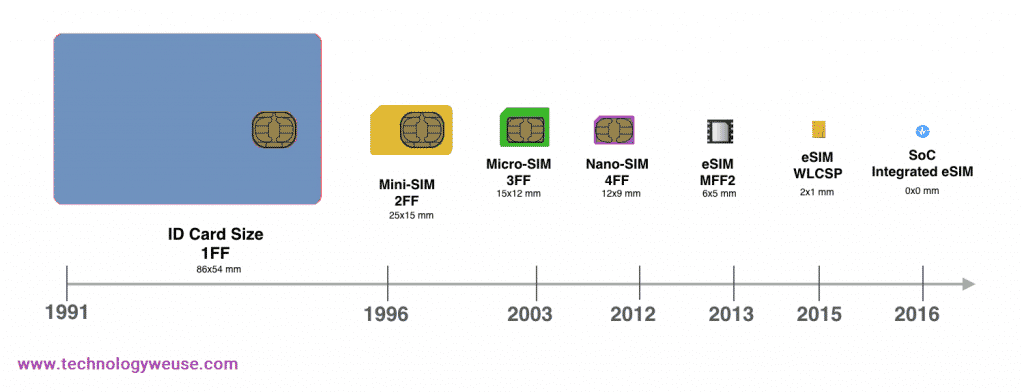Around 50 years ago, no cell phones of any kind existed. There were only traditional wired home phones at that time, which were solely provided and controlled by Telstra – Australia’s oldest and largest telco (previously known as Telecom Australia).
Technology has progressed so far since then that now you can buy smartphones that act as personal, mobile computers that connect to a network using a single tiny component called a SIM (Subscriber Identification Module). A SIM is basically a set of encryption keys and data that uniquely identifies your phone to the network or carrier you’ve chosen.
We have used SIM cards in phones since 1991, and their size has continued to shrink, with a smaller generation of SIM cards introduced every 6-8 years on average.
The most recent evolution of SIM technology – the eSIM – was released two years ago by the GSMA (Groupe Speciale Mobile Association). This international organization set the minimum standards for the new technology, which could potentially eliminate the need for a physical SIM card altogether.
Title: History and evolution of SIM cards
eSIM stands for embedded SIM (or electronic SIM) and it works based on the remote provisioning specification. It’s a small device directly soldered into the circuitry of the phone. In addition to smartphones, a few other mobile devices like smartwatches and fitness bands have utilized eSIMs and there is a growing market for industrial applications.
What is Remote Provisioning?
Remote SIM provisioning is an eSIM specification realized by GSMA. This specification allows consumers to remotely change and activate the SIM profile embedded on portable devices such as smartphones, smart watches, tablet computers, and fitness bands.
At the moment, there are two remote provisioning specifications – M2M Solution and Consumer Solution – both of which simplify the logistic process for device distribution.
M2M Solution
The GSMA M2M solution was the first remote provisioning solution developed for B2B markets such as the automotive, healthcare, transport, and utilities industries. The M2M solution is simpler as no end user interaction is required in the business to consumer segment.
Remote SIM Provisioning for M2M follows a server-driven model to remotely provision operator profiles. It works based on three elements:
- SM-DP (Subscription Manager – Data Preparation):
Responsible for preparing, storing and protecting operator profiles; downloading and installing profiles onto the eUICC. - SM-SR (SM-SR (Subscription Manager – Secure Routing):
Responsible for managing (enabling, disabling, deleting) profiles on eUICC and secures communication links between eUICC and SM-DP for the delivery of operator profiles. - eUICC:
A secure element that features one or more subscription profiles. Each profile enables the eUICC to function like a removable SIM issued by the carrier.
Consumer Solution
The GSMA Consumer solution considers the base provided by the M2M solution and requirements for end-user managed devices. In particular, GSMA’s consumer market solution helps manage the interaction with the end user using the mobile device end user interface. It also supports companion and standalone device types.
The Consumer Solution works based on a client-driven model to allow remote SIM provisioning. It helps manage operator profiles locally by the end user of the device. It works based on the following four elements:
- SM-DP+ (Subscription Manager – Data Preparation:
Creates, download and remotely manages and protects operator credentials. It combines the functions of SM-DP and SM-SR of the M2M solution. - SM-DS (Subscription Manager – Discovery Server):
The SM-DS helps SM-DP+ to reach the eUICC without knowing the network the device is connected to, which is important as devices can be connected using different access networks with different addresses. - LPA (Local Profile Assistant):
A set of functions in devices that allow downloading encrypted profiles to the eUICC; presents a local management end user interface to let end users manage the status of profiles. - eUICC:
Serves the same purpose as it does in the M2M solution, but follows a different implementation to support the end user interaction.
Remote Provisioning
The GSMA has introduced remote SIM provisioning to meet the specific needs of both M2M and Consumer markets. This new GSMA specification allows interoperability between SIM profiles and connectivity platforms, which can now happen automatically and more securely.
But, in addition to the benefits, this revolutionary technology comes with the challenges of its own, in terms of costs and complexity. Looking at the current adoption of remote eSIM provisioning, experts agree that standardizing its implementation into the business processes of the carriers and verifying the interoperability of the tools provisioned by the technology providers would be the steps in the right direction. Remote provisioning and eSIMs allow us to be better connected, more mobile and have control over how we use a network.
